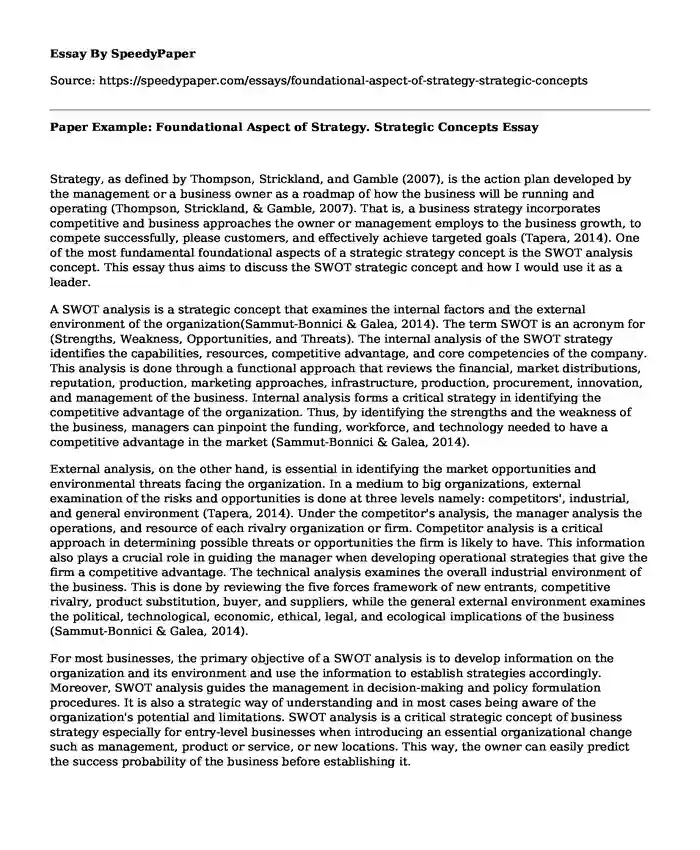
| Type of paper: | Essay |
| Categories: | Strategic management SWOT analysis Business strategy |
| Pages: | 2 |
| Wordcount: | 541 words |
Strategy, as defined by Thompson, Strickland, and Gamble (2007), is the action plan developed by the management or a business owner as a roadmap of how the business will be running and operating (Thompson, Strickland, & Gamble, 2007). That is, a business strategy incorporates competitive and business approaches the owner or management employs to the business growth, to compete successfully, please customers, and effectively achieve targeted goals (Tapera, 2014). One of the most fundamental foundational aspects of a strategic strategy concept is the SWOT analysis concept. This essay thus aims to discuss the SWOT strategic concept and how I would use it as a leader.
A SWOT analysis is a strategic concept that examines the internal factors and the external environment of the organization(Sammut-Bonnici & Galea, 2014). The term SWOT is an acronym for (Strengths, Weakness, Opportunities, and Threats). The internal analysis of the SWOT strategy identifies the capabilities, resources, competitive advantage, and core competencies of the company. This analysis is done through a functional approach that reviews the financial, market distributions, reputation, production, marketing approaches, infrastructure, production, procurement, innovation, and management of the business. Internal analysis forms a critical strategy in identifying the competitive advantage of the organization. Thus, by identifying the strengths and the weakness of the business, managers can pinpoint the funding, workforce, and technology needed to have a competitive advantage in the market (Sammut-Bonnici & Galea, 2014).
External analysis, on the other hand, is essential in identifying the market opportunities and environmental threats facing the organization. In a medium to big organizations, external examination of the risks and opportunities is done at three levels namely: competitors', industrial, and general environment (Tapera, 2014). Under the competitor's analysis, the manager analysis the operations, and resource of each rivalry organization or firm. Competitor analysis is a critical approach in determining possible threats or opportunities the firm is likely to have. This information also plays a crucial role in guiding the manager when developing operational strategies that give the firm a competitive advantage. The technical analysis examines the overall industrial environment of the business. This is done by reviewing the five forces framework of new entrants, competitive rivalry, product substitution, buyer, and suppliers, while the general external environment examines the political, technological, economic, ethical, legal, and ecological implications of the business (Sammut-Bonnici & Galea, 2014).
For most businesses, the primary objective of a SWOT analysis is to develop information on the organization and its environment and use the information to establish strategies accordingly. Moreover, SWOT analysis guides the management in decision-making and policy formulation procedures. It is also a strategic way of understanding and in most cases being aware of the organization's potential and limitations. SWOT analysis is a critical strategic concept of business strategy especially for entry-level businesses when introducing an essential organizational change such as management, product or service, or new locations. This way, the owner can easily predict the success probability of the business before establishing it.
References
Sammut-Bonnici, T., & Galea, D. (2014). SWOT Analysis. (P. S. Cary, & .. Cooper, Eds.) Wiley Encyclopedia of Management, 1-8.
Tapera, J. (2014). The Importance of Strategic Management to Business Organizations. Research journal of Social Science and Management, 122- 130.
Thompson, J. A., Strickland, I. A., & Gamble, J. E. (2007). Crafting & Executing Strategy (15th ed.). New York: McGraw-Hill Irwin
Cite this page
Paper Example: Foundational Aspect of Strategy. Strategic Concepts. (2023, Mar 27). Retrieved from https://speedypaper.net/essays/foundational-aspect-of-strategy-strategic-concepts
Request Removal
If you are the original author of this essay and no longer wish to have it published on the SpeedyPaper website, please click below to request its removal:
- Essay Example: The Culture of a Country Is in the Art of Its Currency
- Western Civilization Essay Example
- Essay Sample on Statistics in Criminal Justice
- Transgender: Should Be Allowed to Use Bathrooms of Their Gender Identity. Essay Sample
- Paper Example. Personnel Management Issues
- Essay Sample. Billy Milligan
- Essay Sample on Cognitive Development Experiment
Popular categories




